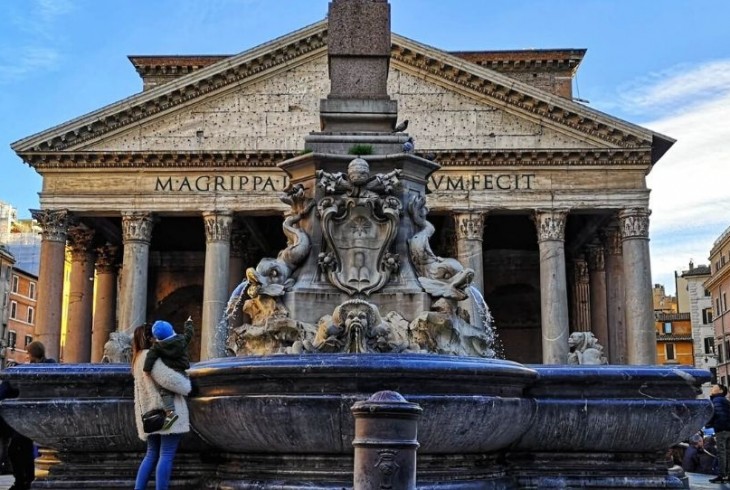Of all the magnificent monuments that dot the landscape of Rome’s historic centre, perhaps none is more evocative or speaks as clearly to the lyrical grandeur of the Eternal City than the Pantheon. The best preserved ancient building in the city, and possible anywhere on earth, the iconic edifice offers a fascinating window into the 2,000-year story of Rome. To celebrate the upcoming launch of our virtual tour of the Pantheon, here’s our guide to 9 things you need to know about the venerable building.
1. The Pantheon was (perhaps) ancient Rome’s temple to all the gods
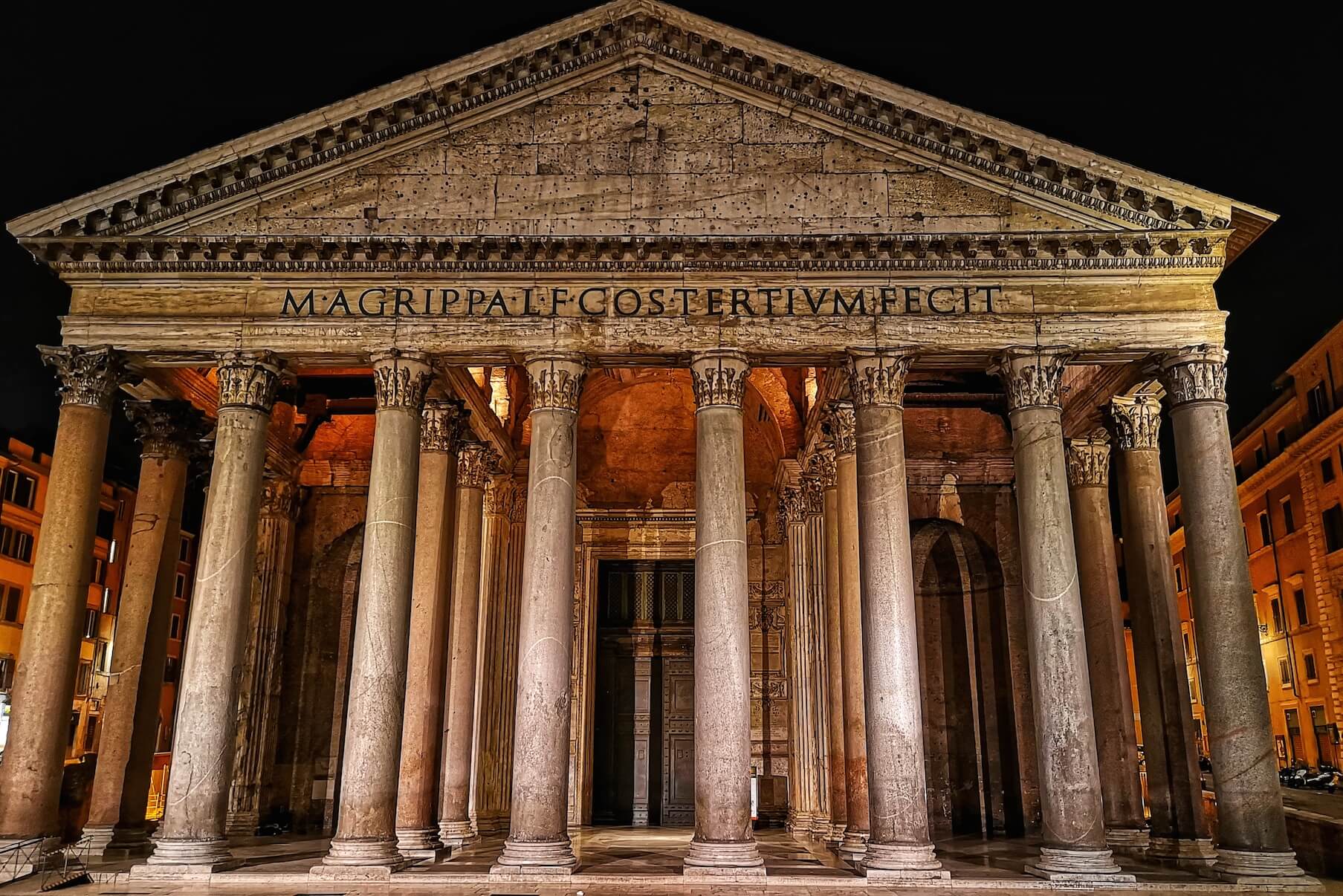
Pantheon means ‘all gods’ in Greek, but the exact function of the great edifice is still shrouded in mystery. As Rome’s grandest and most impressive temple, the Pantheon was originally decorated with statues representing the greatest gods of Roman religion, but whether the Pantheon was explicitly dedicated to the entirety of the Roman deities is unclear.
There is no firm evidence of ancient cult buildings designed to worship the entire pantheon of gods in one place, and writing just 100 years after its inauguration the Roman historian Cassius Dio opined that the building had been so titled instead ‘because its dome resembles the heavens.’ But whatever the exact identity of the deities worshipped at the Pantheon, the incredible temple is certainly a worthy home for any and all gods that choose to make it home!
2. The inscription carved into the temple is misleading

Emblazoned in massive letters across the portico of the Pantheon is an unambiguous message of authorship: M. Agrippa fecit (M. Agrippa made it). Unfortunately, the inscription isn’t quite true. The consul Marcus Agrippa did indeed commission a grandiloquent temple here during the reign of Augustus, but it burned down. When the emperor Hadrian had a new temple built on the same site by his master architect Apollodorus of Damascus in 126 A.D., he modestly retained Agrippa’s inscription.
Unfortunately for Hadrian’s virtuoso master builder, the blandishments of an emperor can be fickle things. A keen amateur architect himself, Cassius Dio recounts that one day Hadrian came to Apollodorus with one of his designs. The old architect unwisely advised the emperor to leave architecture to the professionals, which earned him a one-way ticket to exile and a lonely death.
3. The Pantheon boasts the largest unsupported concrete dome in the world
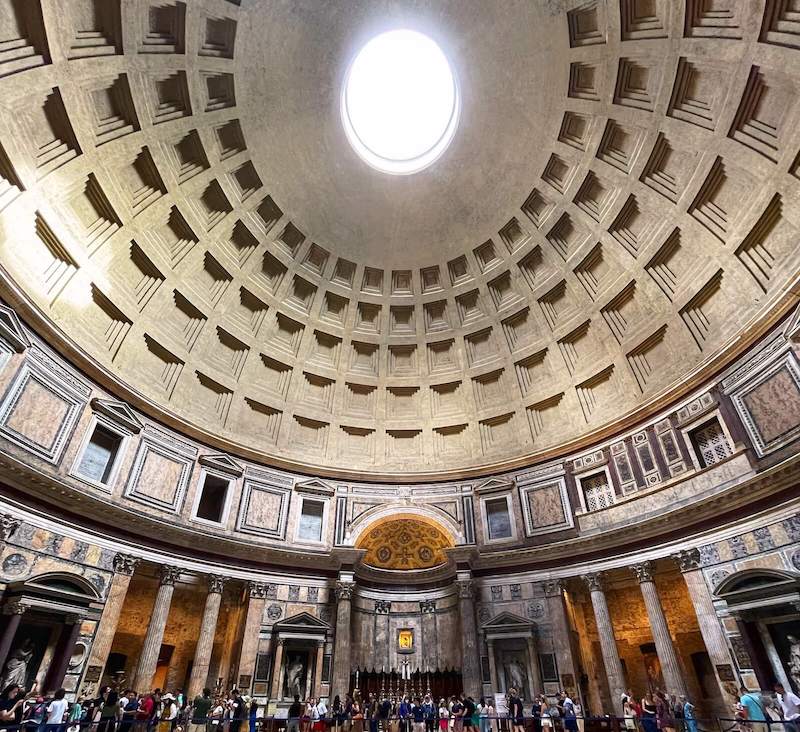
Incredible, but true – in the nearly 2,000 years since the Pantheon was completed, no unreinforced concrete dome anywhere in the world has ever been built on such a scale. But how did the ancient Roman engineers manage a feat that has proved beyond the competence and daring of engineers ever since?
Firstly, a mastery of materials. Romans were experts in concrete, and by adjusting the make-up of the aggregate they succeeding in making the structure of the dome lighter as it rose towards the top. Heavy basalt and travertine stone at the bottom gives way to lighter tufa, whilst the aggregate at the summit is made up of pumice – an extremely lightweight volcanic rock. What’s more, the dome’s walls are much thicker at the bottom than at the top, efficiently spreading the massive load onto the sturdy drum beneath.
The canny Roman engineers had other tricks up their sleeve. The beautiful pattern of coffers you can see on the dome’s interior are more than merely decorative: these hollowed out segments shave a nifty 550,000 pounds off the weight of the dome, lightening the load of the gargantuan edifice still further.
4. The massive columns holding up the portico came all the way from Africa
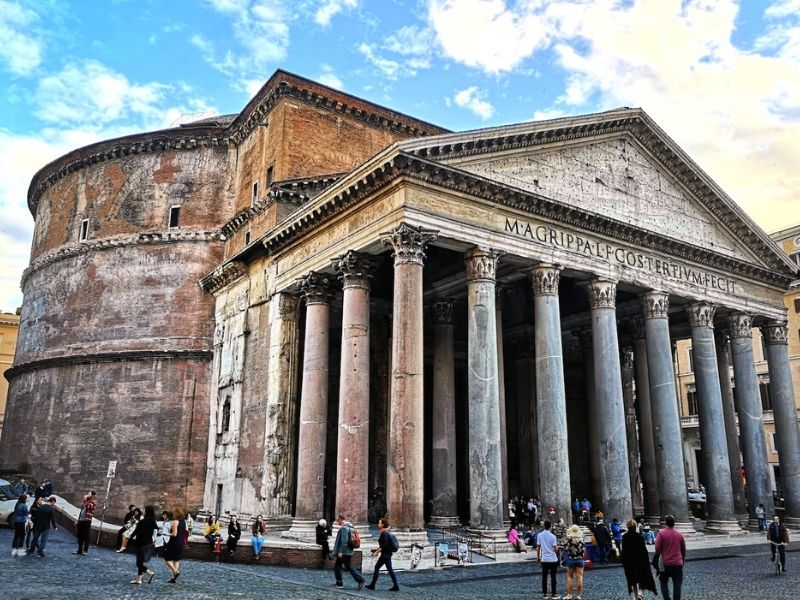
Everything about the Pantheon is conceived on a massive scale, not least its entrance portico. This grand porch is held up by sixteen enormous granite columns, each fully 40 feet tall and 5 feet in diameter. Incredibly, the monolithic columns were quarried and carved in the far-off mountains of Eastern Egypt before being transported across thousands of miles of land and sea to their final home in the Campo Marzio.
The practicalities of undertaking such an endeavour before modern engineering and mechanisation are mind-boggling to contemplate. Dragged on carts down from the quarries to the Nile, the columns were then loaded onto massive barges and floated downriver to Alexandria, where they were hauled onto waiting ships for their seaward journey to Italy. Arriving at the port of Ostia, the process was reversed as they were dragged to the building site and erected by massive teams of toiling labourers.
5. The Pantheon was converted into a Christian church in the 7th century

At first it might seem like an act of unforgivable cultural vandalism: in the year 609 AD, the Pantheon was converted into a Christian church, its venerable history and status as the ancient world’s most august landmark erased in the consecratory rites presided over by Pope Bonifcace IV. Officially the temple is called the Basilica di Santa Maria ad Martyres to this day.
In fact, the Pantheon’s conversion proved to be its salvation, and is the reason why it survives miraculously intact to this day. Whilst other ancient buildings were unceremoniously desecrated, vandalised and plundered over the centuries, the Pantheon’s status as a Christian church meant that it was entirely immune to the ravages of time and greed, and we can appreciate it today much as it was when it was inaugurated in 125 A.D.
6. In the Middle Ages, it was believed the Pantheon’s oculus was made by fleeing demons
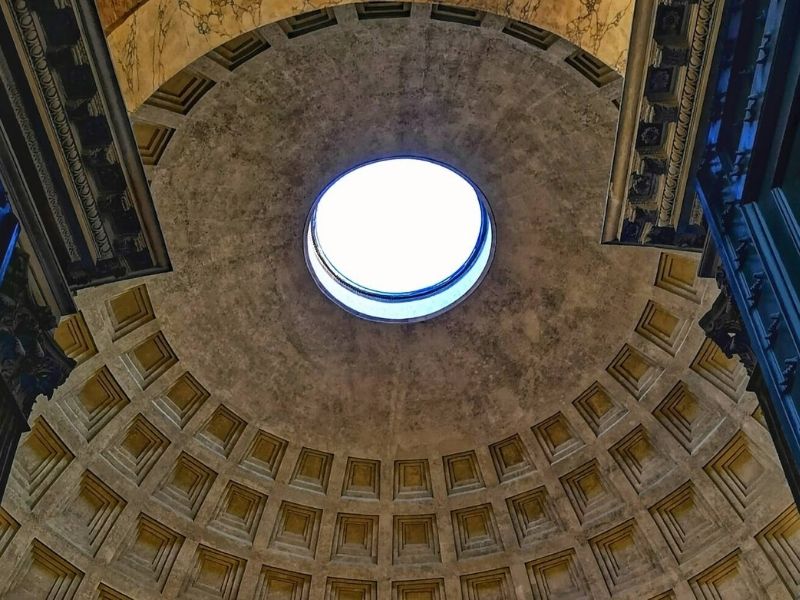
The circular oculus (eye in Latin), or opening, right at the apex of the Pantheon’s dome might be the edifice’s most iconic feature. Allowing spectacular shafts of light to flow down into the Pantheon, these days we know that the 27-feet wide oculus performed a number of important functions – beyond lightening the weight of the dome still further, it’s been theorised that the oculus also served as a kind of massive sundial marking the passage of the hours, as well as illuminating the Pantheon’s doorway on the occasion of Rome’s birthday every year – April 21st.
During the Middle Ages a different significance was given to the mysterious oculus, however. According to medieval chroniclers, the hole was created on the occasion of the Pantheon’s conversion into a church in the 7th century – the legend went that the pagan demons who infested the structure were forced to flee at the moment of its Christian consecration by Pope Boniface IV, bashing a hole through the dome as they beat a desperate retreat from the newly Christened house of God.
7. The Pantheon is the final resting place for Italian kings – and artists
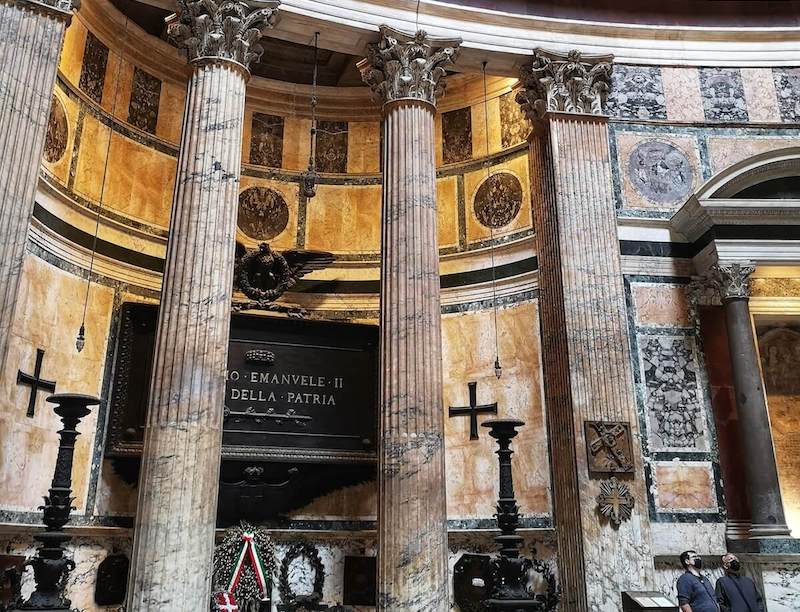
Given that it’s technically a church, it follows that the Pantheon doubles as the final resting place for some pretty important personages. None more so than Vittorio Emmanuele II, crowned the first king of a united Italy for over 1,500 years after the Unification in 1861. The king’s grand tomb is matched by that of his successor Umberto I, who rests in peace alongside his wife Queen Margarita – to whose visit to Naples in 1889 we owe the invention of the pizza margarita by local piazzaiolo Raffaele Esposito.
The Pantheon is also the final resting place for royalty of a different kind – here too you’ll find the tomb of the ‘Prince of Painters’ himself, the incomparable Raphael, who was buried here after his untimely demise at the age of 37 in 1520. And he’s not alone amongst the Pantheon’s pantheon of painters – Baldassare Peruzzi is here too, whose work on the Villa Farnesina alongside Raphael is one of Rome’s great Renaissance treats, as well as Baroque master Annibale Carracci author of the mind-blowing ceiling frescoes in the Palazzo Farnese.
8. Every year on the feast of the Pentecost, rose petals flood the Pantheon
Regardless of your religious convictions, it’s one of the most spectacular and hotly anticipated events on Rome’s cultural calendar: every May on the Christian feast of Pentecost, a shower of thousands of rose petals are released from the oculus of the Pantheon, where they twist and flutter in the air as they make their lazy way down to the temple’s floor. The petals are intended to symbolise the descent of the Holy Spirit onto Christ’s apostles after his death, who were given the miraculous power to converse in all the languages of the world to aid them in their apostolic mission of spreading the word of God. These days, if you want to see the show you had better plan on arriving early – queues to enter begin forming at the crack of dawn!
9. The Pantheon’s dome was originally covered in bronze

In its antique heyday, the Pantheon’s dome would have cut an even more remarkable dash on the Roman skyline than it does today. That’s because the massive dome was originally covered entirely in bronze, which caused it to shimmer and gleam magnificently in the sunlight. Notwithstanding the Pantheon’s conversion into a Christian church, such a valuable depository of precious metal couldn’t lie unplundered forever.
The Byzantine king Constans II nicked most of the bronze in the 7th century, and according to legend, the Barberini Pope Urban VIII completed the job over a millennium later.
Seeking extra bronze to allow Bernini to complete the baldacchino in St. Peter’s basilica, the story goes that Urban ordered his workmen to strip the metal from the Pantheon’s roof. The outrage of the Roman populace at this act of desecration led to one of the city’s most enduring rhymes: “quod non fecerunt barbari fecerunt Barberini” (what the barbarians didn’t do, the Barberini did). The reality might be even less forgivable – scholars now think that the bronze plundered by the Pope was used to cast the cannons atop Castel Sant’Angelo.
MORE GREAT CONTENT FROM THE BLOG:
- How to Visit the Pantheon in Rome
- Who is Buried in the Pantheon?
- The Best New Tours of Italy in 2024
- Where to Take the Best Night Photos in Rome
- How to Visit the Colosseum in 2024
- Where to Stay in Rome in 2024: Areas and Hotels Guide
For over 20 years, Through Eternity have been organizing itineraries showcasing the best of Rome led by our resident expert guides. If you're planning a visit to the Eternal City this Spring, be sure to get in touch to help plan your perfect trip!
